Waqar M. Naqvi 1*
1*Faculty of Physiotherapy, Golf Medical University, Ajman UAE ![]()
ABSTRACT
Background and Aim: The objective of the research is to investigate the impact of lifestyle habits on subjective wellbeing in the presence of role of regulatory emotion self-efficacy as a mediator. Vital for wellbeing, longevity, productivity, relationships, and general quality of life in all areas is a healthy lifestyle.
Methodology: A cross-sectional study has been conducted for 271 Students had been selected as respondents. Smart Pls has been used for calculating the reliability, validity of questionnaire and as well as hypothesis testing.
Results: Food disorder, healthcare anxiety, regulatory emotional self-efficacy have direct and indirect significant impact on subjective well-being. But sleeping disorder has showed the direct and indirect insignificant impact on subjective well-being.
Limitation and Future Implications: Because of time constraints, a lack of comprehension of the research, and a healthy lifestyle people are not aware of health benefits, they had less knowledge about it and were hesitant about a discussion.
Originality: The role of regulatory emotion self-efficacy has not been used as a mediator during the relationship of lifestyle habits and subjective well-being.
Conclusion: Subjective well-being is defined as gratification and satisfaction with one’s life. Regular physical activity is important in order to enhance the self-efficacy and emotional well-being. Good nutrients and a balanced diet provide a person with enough energy to carry out the tasks of daily life effectively.
Keywords: Diet, lifestyle, behavior, classical conditioning, anxiety, indicators, cognition.

Introduction
Subjective well-being is defined as contentment and satisfaction with one’s life. It is a feeling that an individual is living a peaceful and good1. Several unhealthy lifestyle habits like smoking, diet, drug abuse, stress, and physical dormancy impact our well-being and everyday performance2. Various studies show that physical activity and healthy lifestyle habits have numerous physiological benefits3. It has been proven that diet plays a significant role in the vital and good performance of the body4. The Southern European Atlantic Diet is defined as the customary pattern of diet that includes high intakes of the combination of fish, red meat, dairy products, vegetables, and whole grain bread. Information on the Southern European Atlantic diet leads to healthy ageing and aids in psychological well-being5. Unemployment, poverty, and social problems directly impact subjective well-being; those people have financial issues or face social problems, which reduce subjective well-being compared to those who are content with their lives6. Emotional self-regulation is defined as the capability of a person to have power over their emotions, feelings, actions, and behavior toward things occurring in their surroundings7. It has been observed that medical students go through extreme mental distress8. The perception of the Physical health of individuals is essential for subjective well-being. It also examined the relationship between subjective well-being and various health behavior indicators and concluded that lifestyle factors play a role9. Stress affects students’ personal and academic lives through increased dropout rates, poor academic performance, insecurity in personal or academic relationships, and increased substance abuse and suicide attempt. Several studies related to mindfulness have been found, but there is still controversy about operationalizing this idea. Medical students have higher rates of depressive symptoms than their peers10. People can differ in how their lifestyle choices affect their subjective well-being. Finding and implementing lifestyle practices that suit one’s requirements and preferences best is crucial. Furthermore, getting expert assistance from mental health professionals or medical staff can offer individualized direction and support in enhancing subjective well-being29. Endorphins are neurotransmitters that are released during exercise and help people feel happy and less stressed. Additionally, regular exercise can raise mood, boost self-esteem, and generally improve mental health. Exercise, diet, sleep, social interactions, stress reduction, leisure, personal development, and other lifestyle choices all have an impact on subjective well-being30.
In this study, social learning theory is implied to find the relationship. Albert Bandura emphasized the significance of individuals observing, modelling, and imitating behaviors, attitudes, and emotional reactions in social learning theory. Albert Bandura has supported the behaviorist learning theories of classical conditioning and operant conditioning. “Behavior is learned from the environment through observational learning”11.
The findings of this study will contribute to society, considering that lifestyle habits play an essential role in a person’s subjective well-being. Through this research, people would be able to understand how important it is to minimize food disorders, sleeping disorders, and health care anxiety to perform everyday tasks efficiently and live a healthy life. This study will also highlight the mediating role of regulatory emotional self-efficacy on subjective well-being. This study will also help to understand how mental distress, depression, and anxiety among people, especially medical students, demand the encouragement of self-regulation capabilities and skills beneficial in preventing the effects of depression and anxiety. Numerous studies have found a rise in unhealthy lifestyles and physical inactivity. All causes of mortality are increased by sedentary lifestyles, which also double the risk of obesity, diabetes, and cardiovascular disease12. The subjective well-being of people with chronic diseases is associated with food intake and food behavior5. This study examines the impacts of lifestyle habits on subjective well-being and the mediating role of regulatory emotional self-efficacy.
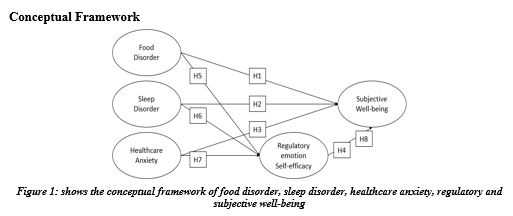
H1: There is a significant impact of food disorders on subjective well-being.
H2: There is a significant impact of sleep disorder on subjective well-being.
H3: There is a significant impact of health care anxiety on subjective well-being.
H4: There is a significant impact of regulatory emotional self-efficacy on subjective well-being.
H5: There is a significant impact of food disorders on regulatory emotional self-efficacy.
H6: There is a significant impact of sleep disorder on regulatory emotional self-efficacy.
H7: There is a significant impact of health care anxiety on regulatory emotional self-efficacy.
H8: There is a significant impact of regulatory emotional self-efficacy as a mediator between food disorder sleep disorder health care anxiety and subjective well-being?
Methodology
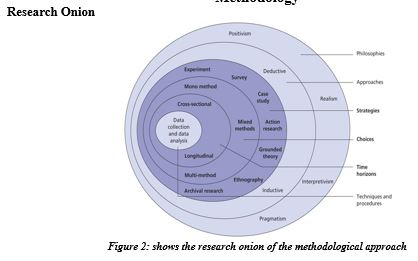
Target Population
271 affiliated students had been selected as respondents from medical universities.
Study Design
A cross-sectional study was conducted for the study.
Duration of Study
The study was conducted during the period of 6 months.
Sampling Technique
A convenient sampling method had been used for data collection.
Sample Selection
Subjective well-being was measured through lifestyle habits (Food Disorder, Sleep Disorder, Health Care Anxiety) and was also calculated the mediation role of regulatory emotion self-efficacy.
Inclusion/Exclusion criteria
All students from Allied Health Professionals studying in 1st, 2nd, 3rd, 4th and 5th Year were selected for the study whereas those who were from Allied fields or doing diploma were excluded.
Data Collection Procedures
An adaptive structure questionnaire highlighting on the lifestyle habits, regulatory emotion self-efficacy, wellbeing, longevity, productivity, relationships, and general quality of life were adapted to formulate a questionnaire. Google forms as an easy and convenient source of data collection was being used to collect the data from the students. A pilot study was conducted to test the reliability of questionnaire.
Data Analysis Procedures
Smart PLS was used for analyzing the reliability and validity of the data, correlation, and as well as for hypothesis testing.
Result
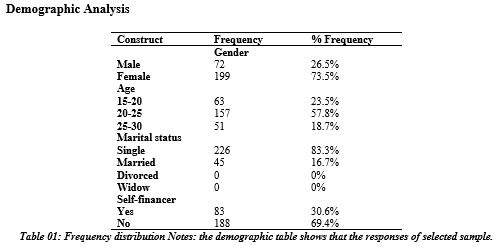
Our results reveals that only 26.5% males responded to the questionnaire. The data shows that 23.5% of the population falls within the age range of 15-20 years old, 57.8% of the population falls within the age range of 20-25 years old and 18.5% of the population falls within the age range of 25-30 years old. This indicates that a large majority of the population are not currently married and are considered single. On the other hand, a relatively small percentage 16.7% of the population is currently married. The data shows that most of the students are not self-financer, because their culture influenced it.
Measurement Modeling
Confirmatory factor analysis (CFA) models are a typical measurement model type. By evaluating the link between the observed variables and the underlying latent variables, CFA is used to test the validity of a measure. This paradigm is frequently used in psychology and social sciences to measure complex phenomena like personality characteristics, attitudes, and intellect13.
Construct Reliability and Validity
The degree to which a measurement tool or procedure regularly yields steady and consistent data over time and across various conditions or settings is known as reliability14. Validity is defined as the accuracy and truthfulness of research findings,”15.
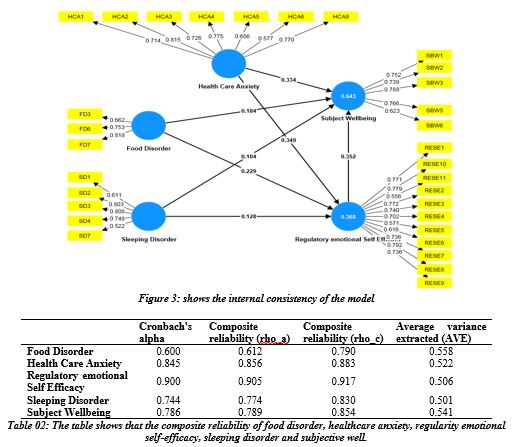
All constructs had dependability values above 0.7016. The authors emphasize the importance of assessing construct validity in PLS-SEM and recommend using AVE as one of the key construct validity indicators. They discuss some of AVE’s shortcomings, such as its sensitivity to sample size and the number of indicators, and suggest using alternative metrics in addition to AVE, such as the heterotrait-monotrait ratio17.
Discriminant validity
- Heterotrait-monotrait ratio (HTMT)
The heterotrait-monotrait ratio (HTMT ratio) is a statistical method for evaluating discriminant validity in structural equation modelling (SEM).
The value of HTMT should be less than 0.85 or 0.9 when using the proposed thresholds, and HTMT=1 should be rejected when using the inference statistic. To prove discriminant validity, the Fornell-Larcker criterion, cross-loading method, and HTMT can only be used on reflective constructs.

Health Care Anxiety and food disorder has a value (0.77) which shows that both are discriminant with each other. The value of Regulatory emotional Self Efficacy and food disorder is (0.666), sleeping disorder and food disorder is (0.809), Subject Wellbeing and food disorder (0.871), Health Care Anxiety and Regulatory emotional Self Efficacy is (0.624), Health Care Anxiety and Sleeping Disorder (0.803), Health Care Anxiety and Subject Wellbeing (0.844), Regulatory emotional Self Efficacy and Sleeping Disorder (0.561), Regulatory emotional Self Efficacy and Subject Wellbeing (0.795), and Sleeping Disorder and Subject Wellbeing (0.748), all show that every variables has discriminant with each other and no homogeneity has been found.

According to Fronell-Larcker criterion, the first and above values should be more than the lower and left values18. The result shows that the value of food disorder is (0.747) which is greater than the value of health care anxiety i.e. (0.557). The value of health care anxiety is (0.723), regulatory emotional self-efficacy (is 0.711), and sleeping disorder which is (0.708) and subjective well-being which is (0.736) all have greater values than their lower and variables values.
Cross loadings
Cross loading can be problematic for discriminant validity, as it hampers the ability to differentiate between latent variables. It indicates that the item may not be a reliable indicator of a specific construct, as it captures variance related to other constructs as well. The value of each observed variables must be greater than (0.5) for same variable and less than (0.5) with other variables which shows that the item of particular variables defines only its own variables characteristics.
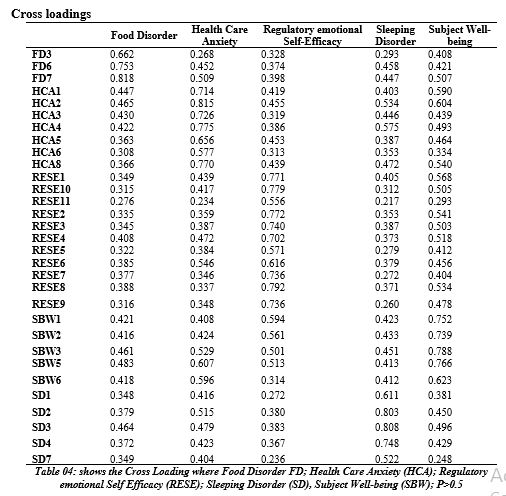
Collinearity statistics (VIF)
Collinearity analysis employing techniques like the Variance Inflation Factor (VIF), it is a systematic resource that could further investigation of the subject of collinearity and its effects on multivariate analysis. Multicollinearity describes a high level of correlation or linear dependency between independent variables19.

When the VIF value is larger than 1, it is indicated that multicollinearity is present; otherwise, it is assumed that there is none. VIF values above 5 or 10 are seen to be indicative of strong multicollinearity, according to widely accepted norms, while the exact cutoff can change depending on the context and subject of research. In above table all variables have less than 5 values which shows that there is no major issue exist between the variables.
Structural Modeling
Partial Least Squares Structural Equation Modelling (PLS-SEM), with a focus on the Smart PLS software, covers the fundamental ideas of PLS-SEM, clarifies the procedures involved in model estimation and evaluation, and offers instructions on how to interpret and report the results20.
Quality criteria
A regression model’s goodness-of-fit is assessed statistically using the R-squared (R2) and adjusted R-squared (R2 adjusted) statistics. They reveal how effectively the model accounts for the dependent variable’s variability in relation to the independent factors.
R-square
The value between 0 and 1, with 0 indicating that the independent variable has no explanatory power and 1 indicating a perfect fit, where all of the variability in the dependent variable is explained by the independent variables. It is the value with error. Here the R-square value of regulatory emotional self-efficacy is 0.368 and the R-square value of subjective well-being is 0.643.
R-square adjusted
The adjusted R-squared value will only rise as more independent variables are included if the effect of those new variables exceeds what would be predicted by chance in terms of the performance of the model. Here the R-square adjusted value of regulatory emotional self-efficacy is 0.361 and the R-square adjusted value of subjective well-being is 0.638.
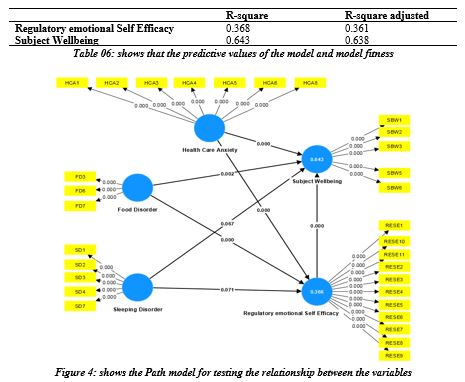
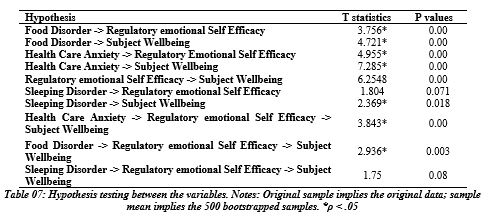
According to the above table, there is a significant impact of food disorder on the subject well-being because the p-value is less than (0.05) which is (t=3.756, p=0.00), which means that if the food disorder exists it decreases the regulatory emotional self-efficacy, and as well as a significant impact on regulatory emotional self-efficacy because the p-value is less than (0.05) which is (t=4.721, p=0.00), which means that if the food disorder exists it decreases the regulatory emotional self-efficacy.
The result shows the significant impact of health care anxiety on regulatory emotional self-efficacy because the p-value is less than (0.05) which is (t=4.955, p=0.00), which means that if the health care anxiety increases or exists it decreases the regulatory emotional self-efficacy, and the significant impact on regulatory emotional self-efficacy is because the p-value is less than (0.05) which is (t=7.285, p=0.00), which means that health care anxiety affects subjective well-being.
Regulatory emotional self-efficacy has a significant relationship with subjective well-being because its value is less than (0.05) which is (t=6.254, p=0.00), explaining that subjective well-being goes better if the human regulatory emotional self-efficacy is in equilibrium.
The result illustrated that sleeping disorder is an insignificant impact on regulatory emotional self-efficacy because the p-value is greater than (0.05) which is (t=1.804, p=0.071), which means improper and unwell sleep did not negative effect on regulatory emotional Self Efficacy, but on other hands, it dramatically affects the subjective well-being, the result shows that the p-value is less than (0.05), which is (t=2.369, p=0.018).
There is a mediating effect of regulatory emotional self-efficacy between health care anxiety, food disorder and subject wellbeing, the values are (t=3.843, p=0.00 t=2.936, p=0.003) but no mediating effect between sleeping disorder and subjective well-being because the p-value is greater than (0.05) which is (t=1.75. p=0.08).
Discussion
According to Albert Bandura (1977), the behaviorist learning theories of classical conditioning and operant conditioning. “Behavior is learned from the environment through observational learning”11. Regulatory Emotional Self-Efficacy and Food Disorder Have a Complex Relationship. Low regulatory emotional self-efficacy makes it difficult for people to control their emotions around food, which can result in disordered eating habits. On the other hand, a high level of self-efficacy can enable people to control their emotions effectively, fostering better connections with food and lowering the chance of developing eating disorders21, 22. Subsequently, as stress is closely related to numerous negative feelings and behaviors in college understudies, decreasing forlornness might help their sound development and contribute to the concordant advancement of schools and society. Regulatory Emotional Self-Efficacy and Sleep Disorder have a substantial link.
Low self-efficacy in controlling emotions can be caused by poor sleep, which can affect emotional regulation. Conversely, those with high levels of self-efficacy are better able to deal with sleep disturbances, improving both the quality of their sleep and their mental health23. There has been expanded intrigue within the cognitive neuroscience of mindfulness over the last decade because of its known cognition, well-being, and well-being benefits. As mindfulness preparing or mindfulness contemplation preparing has been found to diminish a sense of forlornness, there’s presently an assumed relationship between mindfulness and depression. The relationship between mindfulness and subjective well-being has gotten later consideration. For the case, it found that mindfulness was all together and certainly related to subjective well-being, which mindfulness may emphatically foresee subjective well-being. In line with these later ponders, this thought investigated the relationship between characteristic mindfulness, depression, enthusiastic administrative self-efficacy, and subjective well-being in a test of college understudies and, after that, surveyed the impact of characteristic mindfulness on forlornness. It is noteworthy how Regulatory Emotional Self-Efficacy and Healthcare Anxiety are related. People with higher emotional self-efficacy levels can better manage anxiety associated with receiving medical care. In medical contexts, strong self-efficacy can help reduce anxiety, improve healthcare decision-making, and increase general well-being24.
The “Regulatory Emotional Self-Efficacy” concept describes a person’s confidence in their capacity to control and regulate their emotions effectively. Higher levels of Regulatory Emotional Self-Efficacy have been linked to greater subjective well-being, as people with strong emotional self-regulation skills are better able to handle stress, uphold healthy relationships, and enjoy life more fully25. There are a few limitations that were observed in the study as research focused on the students who had enrolled in University and ignored the others because of time limitations, the lack of understanding of research, and a healthy lifestyle people are not aware of health benefits; they had less knowledge about it and were hesitant about it for a discussion26. The qualitative study will be required for more themes, and the open-ended questionnaire can be used for descriptive analysis of individuals’ perceptions of healthy lifestyles27, 28.
Conclusion
Subjective well-being is defined as gratification and satisfaction with one’s life. Various studies show that physical activity and healthy lifestyle habits directly affect physiological well-being. Apart from physical activity, eating habits affect one’s subjective well-being. Good nutrients and a balanced diet provide a person with enough energy to carry out the tasks of daily life effectively. A proper diet has been shown to improve depression, anxiety and several physical symptoms. Not having adequate sleep causes anxiety and constant tiredness among people, affecting their everyday tasks. Hence, people must have healthy sleeping habits to cope with their daily routines and schedules. Healthcare anxiety is defined as constantly thinking about one’s health, symptoms and illness, which a person may or may not have.
Regulatory emotional self-efficacy is defined as having control over one’s emotions. A person should be capable enough to recognize the situation and express their feelings in response to that particular situation. A person should be able to communicate with optimistic emotions in response to a favourable situation and should be able to manage their feelings of anxiety, depression, and misery in a situation of grief and distress. Regulatory emotional self-efficacy is vital to living a peaceful physical and mental life.
AUTHORS’ CONTRIBUTION:
The following authors have made substantial contributions to the manuscript as under:
Conception or Design: Waqar M. Naqvi
Acquisition, Analysis or Interpretation of Data: Waqar M. Naqvi
Manuscript Approval & Writing: Waqar M. Naqvi
All authors acknowledge their accountability for all facets of the research, ensuring that any concerns regarding the accuracy or integrity of the work are duly investigated and resolved.
ACKNOWLEDGEMENTS: The author thanks to all participants.
INFORMED CONSENT: Nil
CONFLICT OF INTEREST: No conflict of interest
FUNDING STATEMENTS: None
ETHICS STATEMENTS: The participant gave both verbal and written agreement prior to the commencement of the data collection, reflecting their consideration of ethical issues. All of the information gathered was kept private, anonymous, and solely used for research purposes.
References
- Parsons H, Houge Mackenzie S, Filep S, Brymer E. Subjective well-being and leisure. Good Health and Well-Being. 2020:678-687.
- Luo M, Ding D, Bauman A, Negin J, Phongsavan P. Social engagement pattern, health behaviors and subjective well-being of older adults: an international perspective using WHO-SAGE survey data. BMC Public Health. 2020 Dec;20(1):1-0.
- Buecker S, Simacek T, Ingwersen B, Terwiel S, Simonsmeier BA. Physical activity and subjective well-being in healthy individuals: a meta-analytic review. Health Psychology Review. 2021 Oct 2;15(4):574-92.3
- Cabiedes-Miragaya L, Diaz-Mendez C, Garcia-Espejo I. Well-being and the lifestyle habits of the spanish population: The association between subjective well-being and eating habits. International Journal of Environmental Research and Public Health. 2021 Feb;18(4):1553.
- Lorenzo PM, Izquierdo AG, Rodriguez-Carnero G, Fernández-Pombo A, Iglesias A, Carreira MC, Tejera C, Bellido D, Martinez-Olmos MA, Leis R, Casanueva FF. Epigenetic Effects of Healthy Foods and Lifestyle Habits from the Southern European Atlantic Diet Pattern: A Narrative Review. Advances in Nutrition. 2022 Sep;13(5):1725-47.
- Hald Andersen S. Unemployment and subjective well-being: A question of class?. Work and occupations. 2009 Feb;36(1):3-25.
- Rodríguez S, González-Suárez R, Vieites T, Piñeiro I, Díaz-Freire FM. Self-regulation and students well-being: A systematic review 2010–2020. Sustainability. 2022 Feb 18;14(4):2346.
- Slonim J, Kienhuis M, Di Benedetto M, Reece J. The relationships among self-care, dispositional mindfulness, and psychological distress in medical students. Medical education online. 2015 Jan 1;20(1):27924.
- Guza E, Gao L, Lippke S. Internet Behavior and Satisfaction With Sleep, Health, Quality of Life and Physical Activity Self-Efficacy as Components of Subjective Well-Being: Findings From an Online Survey. Europe’s Journal of Psychology. 2022 Nov 30;18(4):357-68.
- Slonim J, Kienhuis M, Di Benedetto M, Reece J. The relationships among self-care, dispositional mindfulness, and psychological distress in medical students. Medical education online. 2015 Jan 1;20(1):27924.
- McLeod S. Albert Bandura’s social learning theory.
- Park JH, Moon JH, Kim HJ, Kong MH, Oh YH. Sedentary lifestyle: overview of updated evidence of potential health risks. Korean journal of family medicine. 2020 Nov;41(6):365.
- Kline RB. Principles and practice of structural equation modeling. Guilford publications; 2023 May 24.
- Henson RK. Understanding internal consistency reliability estimates: A conceptual primer on coefficient alpha. Measurement and evaluation in counseling and development. 2001 Oct 1;34(3):177-89.
- Glod M, Creswell C, Waite P, Jamieson R, McConachie H, Don South M, Rodgers J. Comparisons of the factor structure and measurement invariance of the spence children’s anxiety scale—parent version in children with autism spectrum disorder and typically developing anxious children. Journal of Autism and Developmental Disorders. 2017 Dec;47:3834-46.
- Ringle CM, Sarstedt M, Straub DW. Editor’s comments: a critical look at the use of PLS-SEM in” MIS Quarterly”. MIS quarterly. 2012 Mar 1:iii-xiv.
- Sarstedt M, Ringle CM, Hair JF. Partial least squares structural equation modeling. InHandbook of market research 2021 Dec 3 (pp. 587-632). Cham: Springer International Publishing.
- Fornell C, Larcker DF. Evaluating structural equation models with unobservable variables and measurement error. Journal of marketing research. 1981 Feb;18(1):39-50.
- Hair Jr J, Sarstedt M, Hopkins L, G. Kuppelwieser V. Partial least squares structural equation modeling (PLS-SEM) An emerging tool in business research. European business review. 2014 Mar 4;26(2):106-21.
- Hair Jr JF, Sarstedt M, Ringle CM, Gudergan SP. Advanced issues in partial least squares structural equation modeling. saGe publications; 2017 Apr 5.
- Chen G, He J, Zhang B, Fan X. Revisiting the relationship between body dissatisfaction and eating disorder symptoms in Chinese adolescents: the mediating roles of regulatory emotional self-efficacy and depression symptoms. Eating and Weight Disorders-Studies on Anorexia, Bulimia and Obesity. 2021 Feb;26:239-47.
- Annesi JJ, Powell SM. The Role of Change in Self-efficacy in Maintaining Exercise-Associated Improvements in Mood Beyond the Initial 6 Months of Expected Weight Loss in Women with Obesity. International journal of behavioral medicine. 2023 Feb 16:1-7.
- Zheng G, Zhang Q, Ran G. The association between academic stress and test anxiety in college students: The mediating role of regulatory emotional self-efficacy and the moderating role of parental expectations. Frontiers in Psychology. 2023 Feb 7;14:1008679.
- Cuadrado E, Rich-Ruiz M, Gutiérrez-Domingo T, Luque B, Castillo-Mayén R, Villaécija J, Farhane-Medina NZ. Regulatory emotional self-efficacy and anxiety in times of pandemic: a gender perspective. Health Psychology and Behavioral Medicine. 2023 Dec 31;11(1):2158831.
- Albani A, Ambrosini F, Mancini G, Passini S, Biolcati R. Trait Emotional Intelligence and Self-regulated Learning in University Students during the COVID-19 pandemic: the mediation role of Intolerance of Uncertainty and COVID-19 Perceived Stress. Personality and Individual Differences. 2023 Mar 1;203:111999.
- Fuller T, Hasan A, Kamardeen I. A systematic review of factors influencing the implementation of health promotion programs in the construction industry. Engineering, Construction and Architectural Management. 2022 Jun 24;29(6):2554-73.
- Hendren K, Newcomer K, Pandey SK, Smith M, Sumner N. How qualitative research methods can be leveraged to strengthen mixed methods research in public policy and public administration?. Public Administration Review. 2022 Jul 6.
- Zhang L, Huang Y, Yang X, Yu S, Zhuang F. An automatic short-answer grading model for semi-open-ended questions. Interactive learning environments. 2022 Jan 2;30(1):177-90.
- Cabiedes-Miragaya L, Diaz-Mendez C, Garcia-Espejo I. Well-being and the lifestyle habits of the spanish population: The association between subjective well-being and eating habits. International Journal of Environmental Research and Public Health. 2021 Feb;18(4):1553.
- Tao B, Chen H, Lu T, Yan J. The effect of physical exercise and internet use on youth subjective well-being—The mediating role of life satisfaction and the moderating effect of social mentality. International Journal of Environmental Research and Public Health. 2022 Sep 6;19(18):11201.
The Ziauddin University is on the list of I4OA, I4OC, and JISC.
This is an open- access article distributed under the terms of the Creative Commons Attribution License (CC BY 4.0).
